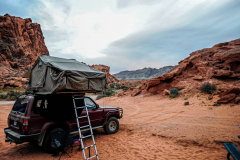We picked up my passport and truck (1991 Toyota Landcruiser FJ80) in Edmonton, and headed south. November 23 – December 6th. Pictures taken with a Leica M240 with Leica -R 19mm lens, Nikon D700 with Nikkor 17-35mm lens. Photos processed in Lightroom. If you have any questions, or comments – drop me a message.

Bernadette – finishing off a pair of socks while i waited in line at Service Canada for 10 hours to pick up my new passport.

Short visit to the Landcaster Museum in Nanton, Alberta. Check out that ancient Avro CF-100 ‘Clunk’ jet, and the equally ancient Landcruiser !
Montana
We simply ‘passed through’ Montana. Road pictures only. Photo gallery below.
Hurricane Mesa (Virgin, UT)
In Virgin Utah, we drove up Hurricane Mesa for un-impeded views of Zion National Park, and drove across the Mesa to the entrance to Zion National Park. Awe-inspiring views of the coloured sedimentary rocks. Photo gallery below.
Logandale Trails (Logandale, NV)
At Logandale we entered the ‘Logandale Trails’ off-road area. Intended primarily for quads and side-by sides. The roads were no problem for our Landcruiser. Again, more red-coloured rocks, although tilted. To the east, on the horizon, perfectly horizontal layers of sedimentary rocks. We passed the parking lot full of campers and RV’s, and empty trailers for off-road vehicles and had the area to ourselves. We camped here for 2 nights, and had a little fun making shadows of ourselves with the truck headlights. Photo gallery below.
Valley of Fire State Park (Moapa Valley, NV)
Valley of Fire is characterized by layers of bright red sandstone and grey limestone. The sandstone was deposited during the Jurassic period (201.3 million to 145 million years ago), by the wind after inland seas subsided and the land rose. Photographically the conditions were challenging – bright sun and no clouds, as such the photos appear over contrasty. we did an early morning walk – but got in trouble from the Park Ranger because we were walking on the road (not a vehicle to be seen for miles !). Yes, the rumour it true – I did knit myself a scarf !. Photo gallery below.






























































































































































































































